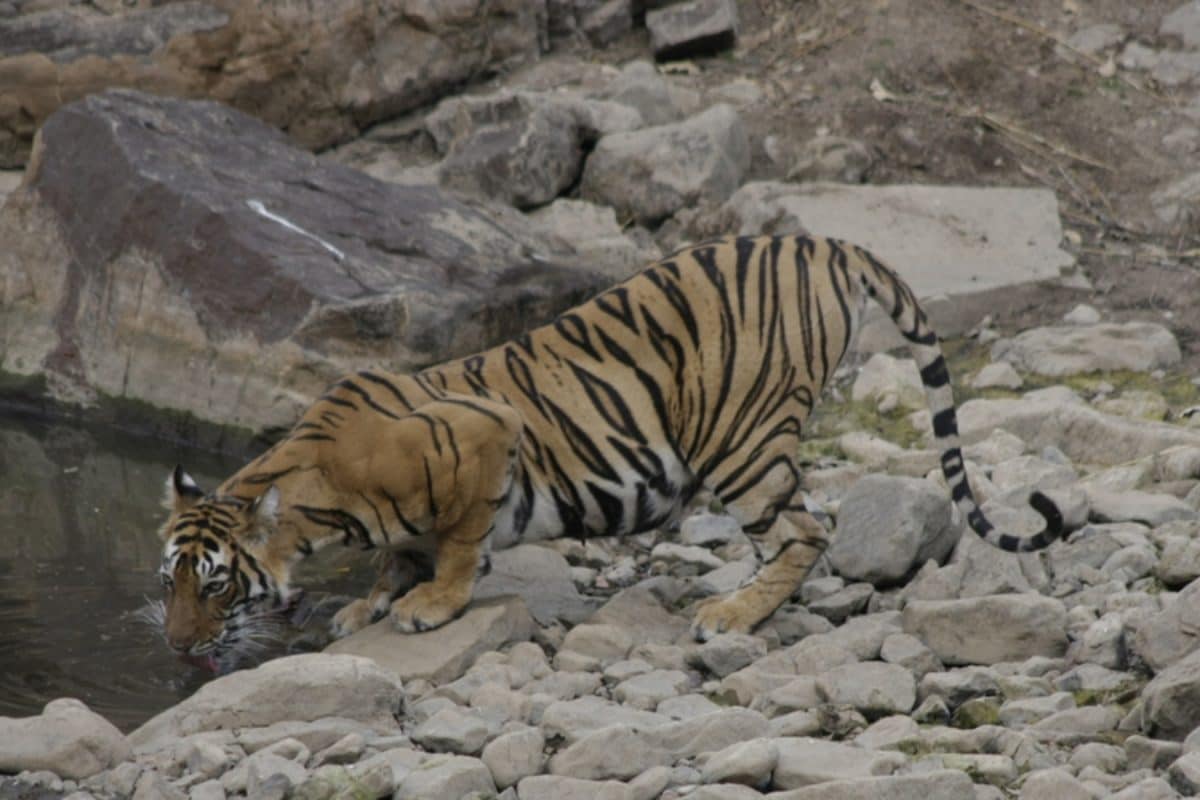‘Ranthambore Diary: 9 Days 9 Cubs’ is a coffee table book written as an epistolary that follows the author’s journey into the Ranthambore forest in his quest to sight the majestic resident tigers Planning a nine-day trip to Ranthambore was a leap of faith. It is an intense experience, particularly with a young child. However, knowing our deep love for tigers and the forest, we were all looking forward to it.
We were staying at the Oberoi Vanyavilas Wildlife Resort, my address in Ranthambore. Situated close to the park entrance, this luxury destination has just 25 rooms that make the most of the location, inspired by Ranthambore’s history as the hunting ground of the maharajas. For our first safari of the trip, we went towards zone one.

On reaching Sultanpur Chowki, through our conversations with the forest officials there, we learned that some movements of the tiger had been observed by the morning safari teams around the area known as the Kali Peeli (black and yellow) water body. We headed there, but as luck would have it, we could not catch any glimpse of a tiger. Through Guptaji Aniket and the new road, we were back in the Chowki area again.
Once more, we missed sighting a tiger. Thereafter, we headed towards the Sukhi Talao or the dried-up lake and there we could see a sloth bear. As per recent surveys, the bear population of Ranthambore stands at around 50, so this sighting was a significant one.
Sloth bears are very fond of termites and honey, which form the bulk of their diet. To satiate their hunger and craving for these two delicacies, bears have often been observed to travel long distances, covering an expansive area of the forest. Now, bears do not have any natural predators, but the tigers of Ranthambore have been known to make them their prey.
A case in point is the tiger Ganesh, who recently hunted down a bear in one of his kills. Then again, there are multiple reports of bears turning the tables and driving away even female tigers. There was a fight between a sloth bear and T-101 in zone five.
It was so sudden that the foreign tourist who witnessed it couldn’t take out his camera because he was frozen with fear. Somehow, the driver managed to click a picture with his phone. The next morning, we went to zone five and found our vehicle at gate two through which we were to enter.
Right in front of our vehicle was another one that was being used by a Japanese wildlife photographer named Koki Yamada. For the past two years, he has regularly visited Ranthambore and taken many photographs. Tiger Laila made a rare sighting last year when we spotted her in the Berda area of zone four.
On the subject of photographers, one of the interesting sights you might encounter in Ranthambore and other national parks are the various kinds of cameras. Long lens cameras can be spotted with a number of tourists keen to capture their animal sightings for posterity. They allow a better and clearer view of the animals, which are often some distance away.
This is what it feels like to be a member of the paparazzi! I have heard from visitors who regret not being able to truly capture the majesty of these creatures with phone cameras and even basic DSLRs. A few good sightings might send you on a rather expensive shopping spree for camera gear. But I’d suggest renting prior to making a commitment.
There is a lot to learn about wildlife photography and it’s not for everyone. As soon as we entered through the gate, we saw pugmarks belonging to possibly a male tiger – a trail which we followed, only to find it ending right before what is known as the Gular ki Kui. The footprints could only belong to the tiger T-101, as he was the only one known to frequent the area.
Thereafter, we proceeded towards the area known as Peeli Ghati and, upon reaching it, were greeted with the alarm calls of frightened monkeys. These cries from langurs, spotted deer and sambar deer are often how alert guides and drivers at national parks can tell in which direction a tiger is moving. They will hear a call and race through the narrow paths that crisscross the forest, hoping to spot an animal.
Sometimes, these efforts pay off. At other times, they will wait near known spots where tigers had been sighted in the past. Being on a safari can be extremely exhilarating, but it also requires a great deal of quiet patience.
Enjoying the forest for its own sake, and deriving pleasure from other animals, such as birds, add much to the experience. One of the most fascinating animals in Ranthambore is, in fact, the tiny, friendly and extremely noisy rufous treepie. This bird fearlessly perches on safari vehicles and has a delightful call.
It is black and orange, much like its most surprising friend: the tiger. Unbelievably, this tiny creature is also known as the “tiger dentist" or the “tiger toothpick". I have been fortunate enough to see them, but have not captured them yet.
It is said that they have the temerity to sit before a tiger’s gaping mouth and clean the apex predator’s teeth! Tigers kill other birds but welcome their tiny synergistic allies in oral hygiene. These resourceful and intelligent birds are related to crows, are omnivorous and adaptable. On that occasion, we waited for a while at Peeli Ghati, hoping to get a tiger sighting, but without a positive result.
We carried on towards the Kachida Mata Mandir, where we came upon many villagers. As per their traditions, they had converged at the mandir on Navratri Ekadashi, where age-old rituals were carried out. It was quite unnerving to know that just days before our trip, on October 2, a villager named Babulal had fallen prey to the tiger T-121 in this very area.
After traversing through Kachida Chowki, we passed by Dhakda, Pipaldaha to reach an area known as Bhakola. During the scorching summer months, this area is famous for tiger sightings, but we were unlucky that day. After waiting for a while and with no noticeable movement anywhere, we headed back towards Peeli Ghati.
Here, we once again crossed paths with Koki Yamada, who was photographing the area amidst the unending calls of monkeys and sambar deer. The tigers, however, remained out of sight. You can get the book here .
The above is an extract from Sundeep Bhutoria’s book, ‘Ranthambore Diary: 9 Days 9 Cubs’, following the author on two safaris into the heart of the jungle. The book features high-resolution pictures taken by Manjari Maheshwari that accompany the text, making for an exhilarating and immersive read. Views expressed in the above piece are personal and solely those of the author.
They do not necessarily reflect News18’s views..
Politics

Book Excerpts | Ranthambore: Much More Than Just A Tiger Habitat

‘Ranthambore Diary: 9 Days 9 Cubs’ is a coffee table book written as an epistolary that follows the author’s journey into the Ranthambore forest in his quest to sight the majestic resident tigers















